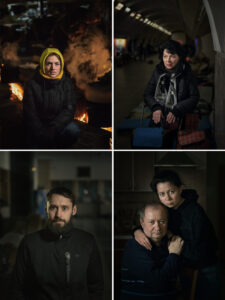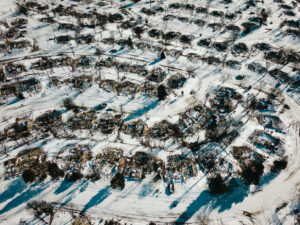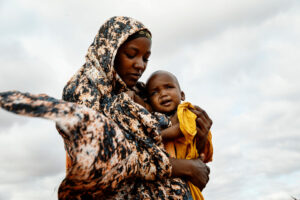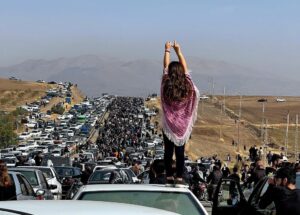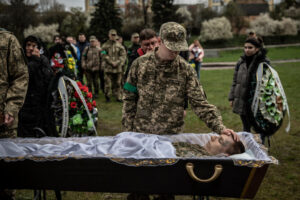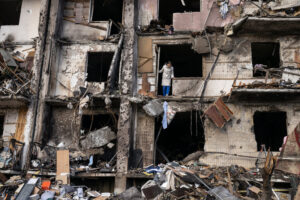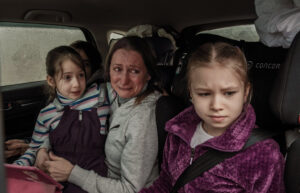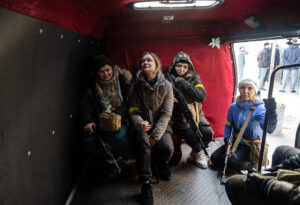BY JOSEPH KAHN, EXECUTIVE EDITOR
The images from the earliest moments of the Ukraine conflict revealed sheer terror and disbelief. War had reached a major European capital, Kyiv, and its immediate outskirts. Refugees shoved their way onto a train headed west, pushing past a woman who shut her eyes and screamed.
A woman and her two children lay dead on a roadside, felled by a blast that narrowly missed our photographer, Lynsey Addario. The first photo we published of a dead Russian soldier in Kharkiv, a day after the conflict began, shows the corpse covered by a fresh dusting of snow.
Every year, starting in early fall, photo editors at The New York Times begin sifting through the year’s work in an effort to pick out the most startling, most moving, most memorable pictures. Recently, every year seems like a history-making year: a pandemic that killed millions; an insurrection at the U.S. Capitol; and, in 2022, a war with frightening echoes of the 20th century’s devastating world wars.
Although the war in Ukraine wasn’t this year’s only story, it was the most dominant — photographers for The Times filed some 16,000 images, often in circumstances that endangered their lives.
After the shock of the invasion, the photos began to change. Lynsey, Tyler Hicks and David Guttenfelder, fellow veterans of conflict coverage, told us that the destruction of an artillery war produces too many similar scenes. They began seeking something different.
As the war ground on, they captured a new mood in facial expressions: resignation, but also resilience. A Ukrainian soldier, on leave from the front, lightly held his girlfriend as he placed a soft kiss on her forehead. In the village of Demydiv, someone carrying a bag waded alone down a street that had become a river, flooded by Ukrainians themselves to thwart the Russian advance.
By April, it had become a war of attrition. Even big battles and major advances proved indecisive, with both sides digging in for an extended conflict.
Looking at these images from 2022, it’s impossible not to see fragments of a different kind of war, one being waged here in the United States, with mass shootings taking lives seemingly every week. Sometimes, the most powerful image is of an object that reveals that pain and tragedy, like Tamir Kalifa’s photograph of a bullet-riddled notebook retrieved from a classroom in Uvalde, Texas, where 19 children and two teachers were killed. The notebook belonged to one of those children — Uziyah Garcia, a 10-year-old.
There was also change on the social and political fronts. Ketanji Brown Jackson was confirmed as the first Black woman on the Supreme Court, a moment caught in a magical photograph of Leila Jackson gazing at her mother in loving admiration. It was taken by Sarahbeth Maney, who is also a young woman of color.
A gorgeous and powerful black-and-white photo of a pregnant woman in Ohio who had made the difficult decision to have a reduction — the termination of one severely unhealthy fetus to save the life of its healthy sibling — spoke to the anguish.
Hers was one of the last such procedures legal under Ohio’s changing law.
But 2022 undoubtedly belongs to the war in Ukraine, a conflict now settling into a worryingly predictable rhythm. Finbarr O’Reilly’s image of an explosion on Kyiv’s skyline, as Russia retaliated against Ukrainian advances with missile attacks on civilian targets, shows the war as raw and low-tech, because it is. Dumb bombs and artillery blow up buildings for the sole purpose of scaring people.
And yet moments of optimism and joy do arrive. A photo by Laetitia Vancon delights us with the sight of elegantly dressed teenagers dancing on a street in Odesa. We see what they have lost because of Vladimir Putin’s aggression against their country — but also what they refuse to lose.
With this collection, we recognize our photographers for their outstanding work around the world, and hope you will understand more about their thinking and their day-to-day processes as they explain, in their own words, how they got the story.
JANUARY

KATERYNIVKA, UKRAINE, JAN. 19.A Ukrainian soldier at a frontline position in the eastern province of Luhansk. The world watched nervously as Western countries warned that Russia was preparing to attack Ukraine at any moment.
TYLER HICKS/THE NEW YORK TIMES

OUAGADOUGOU, BURKINA FASO, JAN. 25. Jubilant crowds gathered in Place de la Nation after the military ousted the country’s president, Roch Marc Christian Kaboré, who had faced mounting public criticism for failing to stem attacks by Islamist militants.
MALIN FEZEHAI FOR THE NEW YORK TIMES

HOUSTON, JAN. 25.Wendy Marcum befriending a dog on the street. In the wake of a divorce, Ms. Marcum experienced homelessness and debilitating depression; after years in shelters, she finally found a place of her own through a rapid rehousing program.
ELLIOT ROSS FOR THE NEW YORK TIMES
Elliot Ross joined Wendy Marcum as she did her grocery shopping for the coming weeks.
“As we were walking the final blocks to her temporary home, this sodden, shivering pregnant dog appeared and went up to Wendy under the glow of a streetlight. Instinctively, she dropped the groceries to the pavement and took this sad, smelly creature into her arms and into the house. I was struck by the parallels between Wendy and the dog — two creatures in need of home and heart.”

LOUISVILLE, COLO., JAN. 2.More than 1,000 homes were destroyed when the devastating Marshall fire, fueled by hurricane-force winds, swept through suburban neighborhoods between Denver and Boulder.
ERIN SCHAFF/THE NEW YORK TIMES
“When you’re standing on the ground, you can’t visualize the scope of the destruction. So pulling back a little and being able to see the scale of it and seeing the whole neighborhood with the curves of the streets, you can see how the whole neighborhood had been laid out.”
— ERIN SCHAFF

BINH THUAN PROVINCE, VIETNAM, JAN. 28.Pham Thanh Hong, a dragon fruit farmer, trimming his trees. Many of Southeast Asia’s fruit producers were forced to abandon their harvest as China’s “zero-Covid” policy closed land borders and tightened the screening of goods.
LINH PHAM FOR THE NEW YORK TIMES

ALMATY, KAZAKHSTAN, JAN. 19. The burned remains of the mayor’s office at City Hall, which was set on fire during widespread protests driven by anger over inequality and the country’s ballooning inflation and fuel prices.
SERGEY PONOMAREV FOR THE NEW YORK TIMES

THE BRONX, JAN. 16. Mourners gathered for a service at the Islamic Cultural Center for victims of a fire at an apartment building that killed 17 residents, eight of them children.
STEPHANIE KEITH FOR THE NEW YORK TIMES

HASAKA, SYRIA, JAN. 27. A woman and child emerged from their home as Kurdish special forces conducted house-to-house searches a week after Islamic State militants stormed a prison holding thousands of their fighters.
DIEGO IBARRA SANCHEZ FOR THE NEW YORK TIMES

MANHATTAN, JAN. 22. A vigil for Jason Rivera and Wilbert Mora, two New York City police officers who were shot while responding to a domestic violence call at a Harlem apartment. Officer Rivera was pronounced dead at the hospital, and Officer Mora died a few days later.
JEENAH MOON FOR THE NEW YORK TIMES

MANHATTAN, JAN. 15.A storefront at the New York Flower Market. Supply chain challenges, labor shortages and poor growing conditions led to a scarcity of fresh flowers, especially the kinds grown for events like weddings.
ERINN SPRINGER FOR THE NEW YORK TIMES
FEBRUARY

BEIJING, FEB. 2.A competitor in the Olympic skeleton event during a training session at the Yanqing National Sliding Center. Beijing became the first city to host both a Summer and Winter Olympics.
DOUG MILLS/THE NEW YORK TIMES

BEIJING, FEB. 15. Loena Hendrickx of Belgium competing in the short program of the Olympic women’s singles competition in figure skating. She didn’t perform as well as she had hoped, and after leaving the ice got a hug from her coach.
CHANG W. LEE/THE NEW YORK TIMES

ZHANGJIAKOU, CHINA, FEB. 11.An emotional Shaun White, the three-time Olympic gold medalist in snowboarding, after completing his final run on the men’s halfpipe in his final Games. He missed out on a medal, coming in fourth. “I’m proud of this life I’ve led,” he said.
CHANG W. LEE/THE NEW YORK TIMES

JOINVILLE ISLAND, THE ANTARCTIC PENINSULA, FEB. 1. A colony of Adélie penguins at Tay Head. Warming linked to climate change is among the factors that have led to sharp declines in Adélie populations in recent decades.
TOMÁS MUNITA

KENTUCKY, FEB. 2. A 12-year-old girl who sought treatment from her pediatrician after cutting herself. Community doctors are increasingly finding themselves at the forefront of mental health care for adolescents.
ANNIE FLANAGAN FOR THE NEW YORK TIMES

BAGHLAN PROVINCE, AFGHANISTAN, FEB. 19. A child working at the Chinarak coal mine. Thousands of Afghans have flocked to the country’s notoriously dangerous mines, desperate to scrape out a living amid an economy in ruins.
JIM HUYLEBROEK FOR THE NEW YORK TIMES

KYIV, UKRAINE, FEB. 25. A woman searched through the debris of a residential building that was destroyed by Russian missiles. The Ukrainian capital was transformed into a war zone as Russia’s invasion was met with fierce resistance.
LYNSEY ADDARIO FOR THE NEW YORK TIMES
Lynsey Addario arrived in Kyiv, Ukraine, on Feb. 14, shortly before the invasion began.
“We went to the site where the building had been attacked that morning. There was a woman who basically just kind of came out to start surveying her house. You need some human interaction when you make these photographs. You have to show the scale, the effect and what’s left behind in people’s lives. That’s the challenge with covering war. This war is an artillery war. We see the same images over and over, and it’s really hard to make anything different.”

KYIV, UKRAINE, FEB 26.Julia, center, a teacher and volunteer, waiting to be deployed in the war. Though vastly outgunned, the Ukrainian Army and a growing corps of civilian volunteers mounted a spirited defense of the capital.
LYNSEY ADDARIO FOR THE NEW YORK TIMES

KHARKIV, UKRAINE, FEB. 25.The body of a Russian soldier lay next to an armored vehicle. Ukrainian troops dug in around Kharkiv, the nation’s second-largest city, as they fought back advancing Russian forces.
TYLER HICKS/THE NEW YORK TIMES
Tyler Hicks arrived in Kharkiv, Ukraine, as Russian forces were mounting assaults on the city.
“There was no way to know if you would run into Russian soldiers. I decided to get out of the car and walk to make sure we weren’t going to drive up to any surprises. There was snow on the ground and I wasn’t sure what I was going to find, but I eventually came upon several Russian soldiers who had been killed. I took the photos as quickly as I could because the area where I was working was exposed, and then I got back to cover.”
MARCH

IRPIN, UKRAINE, MARCH 29. Fighters with the Odin Unit waited to advance in an operation to clear out remaining Russian forces after the Ukrainians retook Irpin. The unit included foreign volunteers, among them Americans and Britons.
DANIEL BEREHULAK FOR THE NEW YORK TIMES

KYIV, UKRAINE, MARCH 4. Families clambered onto a packed train heading west. As Russian forces began to encircle the capital, panicked residents were desperate to get out.
LYNSEY ADDARIO FOR THE NEW YORK TIMES

IRPIN, UKRAINE, MARCH 6. A mother and her two children lay dead as Ukrainian soldiers tried in vain to save a man. They had just crossed a bridge used by other civilians evacuating the fighting when Russian mortar shells began raining down.
LYNSEY ADDARIO FOR THE NEW YORK TIMES
“I was photographing along a civilian evacuation route and was in the actual attack. The shell landed between us. The woman and her two children and the church volunteer were killed. I was just lucky the blast went the other direction and not toward me.”
— LYNSEY ADDARIO

KYIV, UKRAINE, MARCH 2. Taria, 27, in her tent in a subway station, where she was living with her two children. As many as 15,000 people took refuge in the subway system to escape bombings and artillery fire.
LYNSEY ADDARIO FOR THE NEW YORK TIMES

MARIUPOL, UKRAINE, MARCH 9.Emergency workers and volunteers carried an injured pregnant woman from a maternity hospital damaged by Russian shelling. Neither the woman nor her baby could be saved.
EVGENIY MALOLETKA/ASSOCIATED PRESS

FROM THE PROJECT “CITIZENS OF KYIV.” Fortitude, desperation and resolve were etched on the faces of residents of Ukraine’s capital. Clockwise from top left: Natalia Dolinska; Valeria Ganich; Tasia Klochko and her father, Yuri; and Stanislav Sheludko.
ALEXANDER CHEKMENEV FOR THE NEW YORK TIMES
Alexander Chekmenev went to Kyiv, Ukraine, a week after the invasion to take portraits of residents who remained.
“To me, everyone who stayed and was ready to meet the invaders was a hero. They were actors, doctors, pensioners and students, and practically all became volunteers. It was important to show the war through a particular person, so that each of us could look into their eyes and see ourselves in the mirror and ask ourselves whether we would have been able to act as they did.”

PALANCA, MOLDOVA, MARCH 1. Ilona Koval, the choreographer for the Ukrainian figure skating team, fleeing the war with her daughter, left, and a family friend. Many Ukrainians headed west to the safer regions of the country, or onward into Europe.
LAETITIA VANCON FOR THE NEW YORK TIMES
